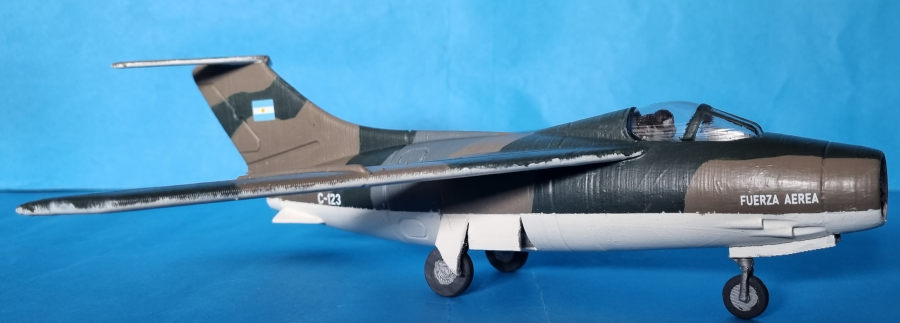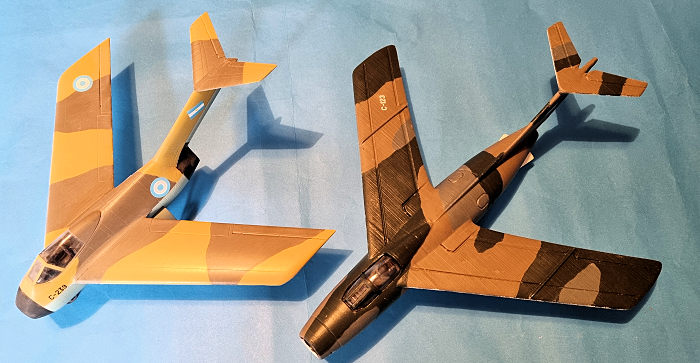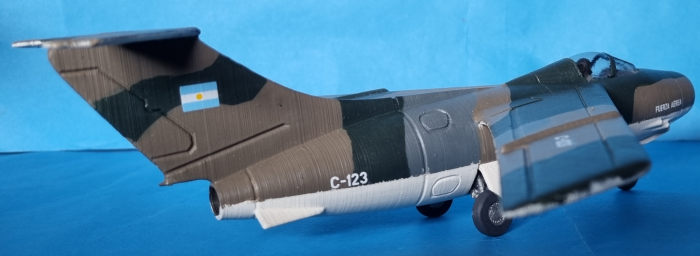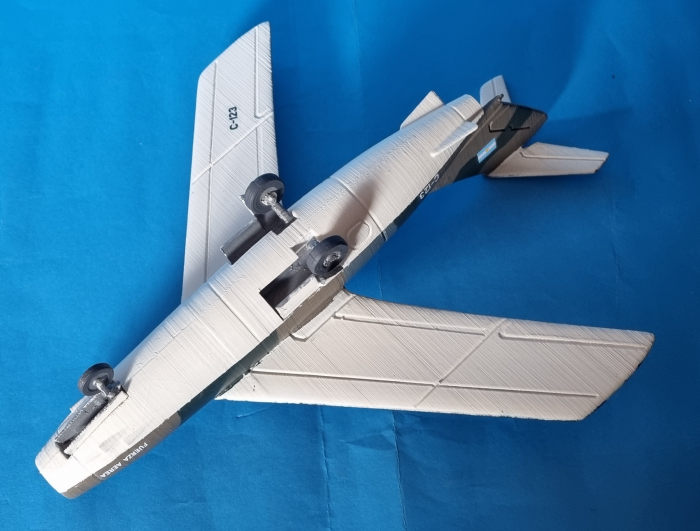
| KIT #: | |
| PRICE: | 25$ |
| DECALS: | Six options |
| REVIEWER: | Francisco Santoro |
| NOTES: | 3D printed model. Decals optional |

| HISTORY |
The I.A.e 33 Pulqui 2 owes its existence to the projected, but never manufactured, Focke Wulf Ta 183. The Ta 183 was a late World War Two German jet aircraft project which aimed to be introduced in 1946, but only reached the wind tunnel stage when the war ended. The plane was designed by Hans Multhop at the Focke Wulf factory. When WW2 ended, Kurt Tank took the plans of the Ta 183 and set sail to Argentina, invited by Juan Domingo Perón. That´s the most known part of the story of the Pulqui 2. I´ll tell you the extended (but not less real) story.
 By
1947, the director of the Instituo Aerotécnico in Córdoba (Argentina) Juan
Ignacio San Martín ordered engineers Norberto Morchio and Humberto Ricciardi to
design a jet aircraft capable of beating a speed record set by a RAF Gloster
Meteor, and two replace the Gloster Meteor Mk.4s in use with the Fuerza Aérea
Argentina. The two engineers weren't without experience in jet aircraft
construction. Together with Émile Dewoitine, a French aircraft designer, they
built the straigh winged Pulqui 1, of which a single prototype was built. This
aircraft allowed Argentina to become the 8th country in the world to have a
locally manufactured jet aircraft. The arrival of the Rolls Royce Nene jet
engine allowed Argentinian designers to think beyond the Pulqui 1, into a swept
wing aircraft.
By
1947, the director of the Instituo Aerotécnico in Córdoba (Argentina) Juan
Ignacio San Martín ordered engineers Norberto Morchio and Humberto Ricciardi to
design a jet aircraft capable of beating a speed record set by a RAF Gloster
Meteor, and two replace the Gloster Meteor Mk.4s in use with the Fuerza Aérea
Argentina. The two engineers weren't without experience in jet aircraft
construction. Together with Émile Dewoitine, a French aircraft designer, they
built the straigh winged Pulqui 1, of which a single prototype was built. This
aircraft allowed Argentina to become the 8th country in the world to have a
locally manufactured jet aircraft. The arrival of the Rolls Royce Nene jet
engine allowed Argentinian designers to think beyond the Pulqui 1, into a swept
wing aircraft.
Back to Tank. When Ricciardi and Morchio presented their plans to San Martín, they were surprised to see Doctor Matties and his helper, Chöel. After a brief exchange of opinions, Matties presented the plans of the Ta 183 to San Martín. The Argentinian engineers didn´t know who the Germans really were. They're ordered to work together with the Germans.
Works on the Pulqui 2 begin in earnest, and the first two prototypes are
ready by 1949. One is a glider, and the other is a powered aircraft. The first
flight is done in July 1950, with Argentinian pilot Edmundo Weiss at the
controls. The second test flight is done on the same month, this time with
German pilot Otto Behrens on the controls. While flying, he encounters
instability, and destroys the landing gear when he lands. After reporting to
Tank, Behrens tells him the Pulqui 2 is "the most dangerous aircraft he´s ever
flown." Tank flies the aircraft personally 28 times between October 1950 and May
1951. Between those test flights, the aircraft is presented to
 Perón at
Aeroparque (AEP/SABE) in February 1951. However, times were changing. San Martín
wasn´t present during the Aeroparque demonstration. He was sent to Córdoba to
become a strongman for the president. The Instituto Aerotécnico was also
dissolved, and became part of the IAME (Industrias Aeronáuticas y Mecánicas del
Estado). This organization was focused mainly in the manufacture of cars and
other machinery, the Pulqui 2 being relegated. Work on the project is still
going though, with 3 more prototypes built until 1960.
Perón at
Aeroparque (AEP/SABE) in February 1951. However, times were changing. San Martín
wasn´t present during the Aeroparque demonstration. He was sent to Córdoba to
become a strongman for the president. The Instituto Aerotécnico was also
dissolved, and became part of the IAME (Industrias Aeronáuticas y Mecánicas del
Estado). This organization was focused mainly in the manufacture of cars and
other machinery, the Pulqui 2 being relegated. Work on the project is still
going though, with 3 more prototypes built until 1960.
However, the Pulqui 2 project received a death blow when three pilots died because of three different malfunctions of the plane (break up of the fuselage, stall, and failure in the Oxygen system). The fifth and last prototype was presented for the 150 years of the Revolución de Mayo in Argentina. After that, it was sent back to Córdoba and stored in a hangar. Derelict, it was then restored, and by 1964 the aircraft was put in exhibition at the Museo Nacional de Aeronáutica in Buenos Aires, Morón. It's still there, all shiny, wearing the prototype's white colour with a red cheatline on the sides.
The Meteors in the end were replaced with used F-86F-40s.
| THE KIT |
Other than being useful for small parts, 3D printing is a perfect way of getting things mainstream manufacturers won't touch, such as the Pulqui 2. This model is manufactured by KosmoSur 3D in Argentina. The model is moulded in white, and comes divided in 10 parts: A forward and rear fuselage, three wheels, the wheel wells, a pilot figure, and a vacuformed canopy.
Decals are supplied as an extra with the kit. They're from Calcas del
Sur, also from Argentina. The sheet offers enoug h
decals to make two full aircraft, five prototypes and a what if operational
version.
h
decals to make two full aircraft, five prototypes and a what if operational
version.
| CONSTRUCTION |
I began construction by gluing the rear and forward fuselage together with epoxy glue. While the glue was hardening, I worked on the wheels and wheel wells. The first ones were painted with steel hubs and tyre colour rims. The wheel wells were then painted in steel (because I don't know how the IRL's aircraft wells are painted). I then went back to the airframe, which had the union filled with CA and sanded down with 800 grit sand paper.
| COLORS & MARKINGS |
I chose to paint my model with the what if operational scheme of the F-86. The colours I used were Revell Aqua 87 Earth, 79 Grey Blue and 40 Black Green. The undersides were painted in Matt White 05. I also painted the gear doors (which come attached to the wheel wells). The model was then glossed, decalled and matt coated. I also painted the pilot with an olive drab suit, black helmet and silver goggles.
I glued the gear wells, wheels and canopy in place.
| CONCLUSIONS |
3D printing is still a fresh industry. Its main advantages are that you can get models no mainstream manufacturer would release. The downside are the ridges created by the printing. I also think this is the first time a 3D printed model is reviewed in MM, so I hope you like it.
Francisco Santoro December 2022 Copyright ModelingMadness.com. All rights reserved. No
reproduction in part or in whole without express permission from the editor. If you would like your product reviewed fairly and fairly quickly, please
contact
the editor
or see other details in the
Note to
Contributors.